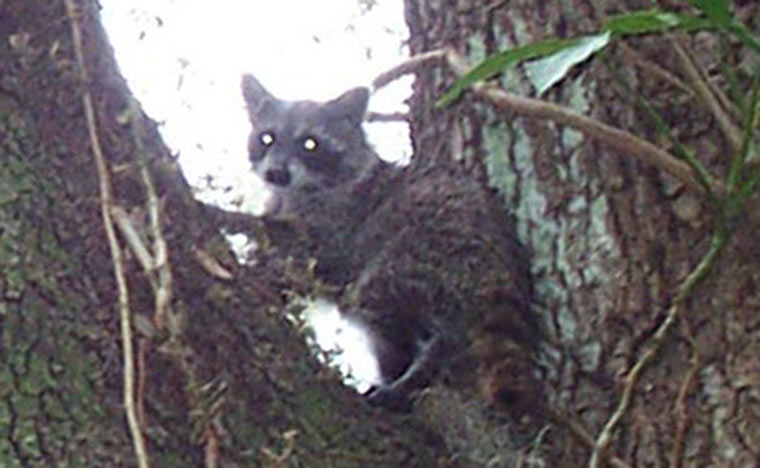- info@wildlife-removal.com
Call us for help in your town
Wildlife Removal Education
The Full Guide to Keeping Raccoons Out of Your Bird Feeder
Need raccoon removal in your hometown? We service over 500 USA locations! Click here to hire us in your town and check prices - updated for year 2020.
There are a number of signs that point right to the direction of raccoons getting at your bird feeder. Perhaps the food is going down a lot quicker than it usually does? You may even find that bits of the bird feeder have been broken off. In some cases, the bird feeder itself is lying on the ground, no longer reminiscent of a bird feeder at all.

The culprit? It's more than likely a raccoon, although, there are other animals that will feed on the nuts and seeds inside the container designed for birds.
The raccoon is a determined and stubborn opponent and once he or she has worked out that your bird feeder provides all the food they need, they'll be remarkably difficult to get rid of. There are ways that you can successfully keep raccoon out of a bird feeder, of course, and for the most part, it just requires a few simple modifications or extras.
Remove Feeders From Trees
This really isn't a way around this, unfortunately; moving the bird feeder away from trees and tree branches really is going to go a long way to protecting it. Raccoons use trees to get about. They live in areas of heavy forest or trees, mostly because an upwards direction gives them a lot more safety than what anything on the ground could offer.
Branches are regularly used by raccoons to get to the upper levels of your home — usually the parts that aren't frequently visited by people, giving the animal an opportunity to set up a home somewhere it won't be disturbed too much. Branches are also regularly used by raccoons to get to bird feeders and other similar sources of food. If you take away the branches, you start to take away the problem.
Bird feeders are much better when places on top of poles, with a baffler attached. In fact, this brings us nicely to our next bird feeder modification to keep raccoons out …
Add a Baffler
This dome-shaped device can be affixed to bird feeders that are high-up on poles. Although these poles are said to make it tough for nuisance wildlife to get to the feeder, they can still access it, but the baffler makes it impossible for them. They can get a certain height up, but they are then met by the baffler that prevents them from going up any further. That is, of course, unless they simply clamber over that too. It's difficult; not impossible.
You can buy a relatively cheap baffler for around $20, although the slightly more aesthetically pleasing ones do tend to come with a higher price tag attached.
Take It Inside
This is a bit of an effort-filled approach, but you could consider moving your bird feeders inside overnight. Why? Because raccoons are mostly nocturnal; when the birds are mostly sleeping. The birds don't actually need the feed to be left out overnight — you could simply pop it outside when you wake up in the morning, perhaps when you let the dog out?
If you don't have a source of food there to begin with, the raccoon won't try and access it.
Be Clean, Be Tidy
While we're on the subject of food, any kind of food that you leave outside, particularly overnight, is going to become the sort of thing that attracts a raccoon to your land. Read more about How to keep raccoons away. The more you tidy up after yourself, the less chance that you will leave food lying around. Birds, for example, frequently make a mess when visiting bird feeders, distributing the nuts and seeds across the floor below it, and then even perhaps for some distance further. These seeds and nuts are sniffed out by hungry passing scavengers, such as raccoons, and they familiarize themselves with your land. It won't be long before they learn that the bird feeder itself is the source of food, and that you refill it every day or every few days, giving the scavenger a CONSTANT and STEADY source of food.
If you take that away — clean up after the birds and make sure there isn't anything lying around to attract the raccoon in the first place — the raccoon will be less inclined to firstly, take a sneaky peek and, secondly, stick around.
Of course, you could always cut down on the amount of feed that you're putting out. If the birds aren't eating everything there, perhaps add a little more than usual next time you fill it? You'll save a bit of money, the birds still get fed, and there'll be a little less mess for you (or the raccoon) to clean up.
There are plenty of things that you can do to try and make your bird feeder safe from raccoons, including looking at repellents — lights and ultrasonic noise devices, and even taste or aversion deterrents — things that taste or smell bad that are said to drive the scavengers away. The more methods and approaches you take, the better the outcome, but we would ALWAYS recommend at ensuring there is nothing on your property to encourage these critters in the first place. They came closer because YOU left something out to encourage it. Now you need to take that away. Read more about raccoon feeding habits.
Go back to the Raccoon Removal page, or learn tips to do it yourself with my How to Get Rid of Raccoons guide.


















